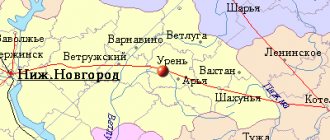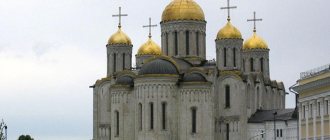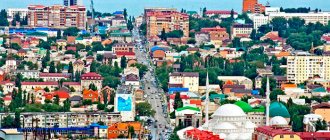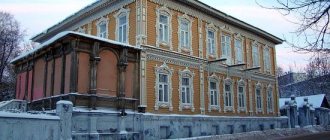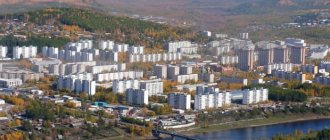Sharya
| Year of foundation: | 1906 |
| Population: | 23.7 thousand people |
| Residents: | Sharya residents |
| Timezone: | UTC+3 |
| Time: | Moscow |
| Telephone code: | +7 49449 |
| Telephone information: | (49449) 2-39-38 |
| Postcode: | 157500 |
The city is located on the left low bank of the Vetluga River. The city of Sharya owes its foundation and development to the railway laid here at the beginning of the last century. The construction of the Vyatka-Vologda railway was carried out by the construction department using funds from the state treasury. Construction of the road and the Sharya locomotive depot began in 1903, and in June 1906, a section of the road was put into operation. At the beginning of 1907, work on the construction of a locomotive depot was completed. In the same year, the construction of the station, water pumping station, 21st railway school, hospital with clinic and residential buildings along Vokzalnaya St. was completed. Sharya. During construction, the labor of peasants was mercilessly exploited. On the site of the current warehouses of the inter-district base, a cemetery arose, popularly called the Tatar cemetery, where construction workers who died from overwork and unsanitary living conditions were buried.
Today Sharya is a developed industrial city. The names of many famous cultural and artistic figures are associated with the city. Melnikov-Pechersky and Nemirovich-Danchenko wrote about Vetluga; the story “The River Plays” was written by the writer Korolenko. M. Bazankov, A. Belyaev, O. Khomyakov were born and worked here.
Since 1991, 4 Orthodox churches have been opened in Sharya. Until 1991, the building of the St. Nicholas Church in the city center was used as a local history museum. On June 25, 1991, the building of the St. Nicholas Church was returned to the church community. In January 1998, St. Nicholas Church burned down and was rebuilt a few years later. Now there are three churches in the city. The revived wooden church of St. Nicholas became the center of the Sharya deanery. At the Alekseevsky Church there is a military-patriotic club in honor of Theodore Stratilates. Among cultural institutions, the Sharya Local History Museum occupies a special place. Local attractions also include the Lagunin estate (a park and a pond have been preserved) in the village of Rozhdestvenskoye and the spring of St. Barnabas in the village of Ivanovskoye.
At first glance, Sharya seems like a distant provincial town, but there is still something attractive about it. The city owes its birth to the railway, which was put into operation in 1906. And a year later a station, a water pumping station, a school, a hospital and the first residential buildings appeared here. The station, located 701 km from Moscow, received its name in honor of the small Sharinka River, a tributary of the Vetluga. And in 1938, the workers’ settlement, in which 12 thousand people already lived, acquired the status of a city.
The Great Patriotic War had a serious influence on Sharya. Firstly, every third of its residents died at the front - more than 8 thousand people. Secondly, trains with evacuated residents of besieged Leningrad stopped at the local station. Not everyone survived the difficult journey in the heated vehicles: hundreds of Leningraders found peace in the city cemetery.
How to get to Sharya
Sharya is a large railway junction. Every day 3 trains depart from Moscow and stop at a local station. Trains whose final destinations are Khabarovsk, Chita and Abakan depart at 0:35, 13:50 and 23:05, respectively, from the Yaroslavl station. After 11-13 hours they are already in place. Buses run from Kostroma to Sharya: 6 trips per day, starting at 6:00; travel time - 5 hours 40 minutes.
The city is small, but there is public transport - it is represented by 6 bus routes. Fare: 19 RUB. Prices on the page are for October 2022.
Hotels
There are only one or two hotels in Sharya. But local hotels have quite a decent number of rooms at a very attractive price. A double room will cost 1300-1500 RUB per day. Hotels in the city are not officially classified, but in general they correspond to a confident two “stars”.
Book popular Sharya hotels at the best prices
Cuisine and restaurants of Sharya
You can have a tasty and inexpensive lunch in one of the local cafes - the complex will cost only 100 RUB. Even cheaper - in numerous nameless canteens and bars. Higher-class establishments are mainly pizzerias, where, in addition to Italian, Russian cuisine is also widely represented. Pizza costs 200 RUB, a portion of pancakes with salmon costs 150 RUB. Dinner in one of the city’s restaurants costs about 500 RUB per person.
Inexpensive buffets operate at hotels in Sharya. You can have a hearty dinner there for 200-300 RUB per person without alcohol. Fast food is represented by shawarma and hamburgers, which you can take with you in almost any cafe for 100-150 RUB.
Attractions
Almost all the sights of Sharya are connected either with the railway or with religion. Now there are three Orthodox churches in the city. Among them is the wooden Church of St. Nicholas, built in the 19th century. In Soviet times, it was destroyed and a local history museum was built on the remains of the foundation. Then the building was given to the temple, but it was inconvenient to pray in the museum. Already today, local logging entrepreneurs provided building materials, and the church was restored. In addition to Nikolaevskaya, there are Alekseevskaya and Nativity of Christ churches in the city.
Among the cultural institutions, the Sharya Museum of Local Lore is interesting. Its exhibition is presented in 7 sections, telling about the history of the region from the 19th century to the present day, about the indigenous peoples who have lived on this land for centuries, about the flora and fauna of the region. Opening hours: Monday-Friday: 9:00-17:00, Sunday: 9:00-15:00, Saturday - closed. Entrance: 150 RUB, children: 100 RUB.
There are several iconic places in the vicinity of Sharya. The Nikolo-Preobrazhensky Church in the village of Nikolo-Shanga, built in 1806, is complemented by a stone bell tower and a beautiful fence. Nearby is a cemetery with a prayer house. 40 km from the town, in the village of Rozhdestvenskoye, there is a spring of St. Barnabas of Vetluzhsky. Even during the times of the USSR, the flow of believers from all over the country did not stop. Sometimes it was covered with cement mortar, but water still made its way out. Today, the miraculous spring has been updated and restored, and a chapel has been erected nearby. The Lagunin estate is located in the same village. Currently, there is a pond and a park on the estate that are accessible to the public.
Sharya is an urban district of regional subordination, an industrial and cultural center of the northeast of the Kostroma region with a population of about forty thousand people. The city is located on the left low bank of the Vetluga River and covers an area of 2530 hectares. The city of Sharya its foundation and development to the railway laid here at the beginning of the last century. On November 24, 1906, the official opening of train traffic took place, and the new railway began to be called Northern, and the station, located 701 km from Moscow, became Sharya, named after the river flowing two hundred meters from the station. From the ancient Meri language (this people settled here in time immemorial), the word “Sharya” is simply translated as a river. In contrast to the station, this river was later called more affectionately – Sharinka. The station was gradually rebuilt and in 1917 it became a large settlement with a locomotive and carriage depot. In 1938, by the Decree of the Presidium of the Supreme Soviet of the RSFSR dated November 27, the working village of Sharya was transformed into a city with a population of about 12 thousand people. With the formation of the Kostroma region in 1944, Sharya became part of it and was classified as a city of regional subordination. During the Great Patriotic War, about 24 thousand residents of the city defended their Motherland with weapons in their hands. Almost 8,000 - one in three - died in battle. Sharya residents are proud of the exploits of their fellow countrymen - Heroes of the Soviet Union: D. Koryagin, who repeated the feat of Gastello; V. Tanycheva, A. Kotegov, I. Bobarykina, V. Dusheina; – full holders of the Order of Glory: S. Gromov, A. Krasnukhin. In the year of the 60th anniversary of the Great Victory, grateful residents of the city opened a Memorial complex, where the names of all fallen fellow countrymen are immortalized in bronze and granite. In the 50s–70s the city actively developed. PDO "Sharyadrev" from a timber processing plant has turned into the largest city-forming enterprise. Sewing and furniture production appeared, and the number of food industry enterprises increased. Construction was proceeding at a rapid pace in the city, new neighborhoods, hospitals, schools, colleges were growing. Today Sharya is a developed industrial city. The modern industry is represented by large forestry and woodworking enterprises, LLC Kronostar and LLC Lesopromyshlenny Kompleks, together with which timber industry enterprises are being revived and furniture production is developing. In the food industry, an enterprise for the production of mineral water arose, and today Sharya Mineral is known throughout Russia. Sharya has an advantageous transport and geographical location. It is located at the crossroads of federal highways from north to south and from west to east. Due to the abundance of road traffic, a bypass road was built. Its interchange is a complex engineering structure. The railway junction continues to develop; a steel main line runs through Sharya, connecting Moscow and Vladivostok. Thanks to rich natural resources, a revitalized economy, the availability of qualified personnel, and the gradual development of infrastructure, Sharya is becoming an attractive region for investment.
Today Sharya is the cultural and educational center of the northeast of the region. There are 4 secondary specialized educational institutions in the city, branches of KSU named after. ON THE. Nekrasov, Modern Humanitarian University, International Law Institute under the Ministry of Justice of the Russian Federation and Moscow Institute of Economics, Management and Law. Along with education, spirituality is also being revived. Now there are three churches in the city. The revived wooden Church of St. Nicholas became a real work of art. Among cultural institutions, the local history museum occupies a special place. Its exhibitions tell about certain periods in the life of the city. Names of local artists: S.F. Bogorodsky, A.M. Kuchumova, V.M. Fedorov, are well known outside the region. The names of many famous cultural and artistic figures are associated with the city. Captivated by the beauty and mystery of Vetluga, both Melnikov-Pechersky and Nemirovich-Danchenko wrote about it; the amazing story “The River Plays” was left to us by the writer Korolenko. M. Bazankov, A. Belyaev, O. Khomyakov were born and worked here. Every year, with the active assistance of the city district administration, new books are published about Sharya and its residents, as well as the work of local poets and writers. The crowning achievement was the book “Years and People” (author – N.V. Golyanov, local historian and patriot of his city), where two volumes tell about the fate of the Vetluzhsky region and the people of Sharya during the Great Patriotic War. The names of our champions and winners of major competitions are known far beyond the region: L. Kolchanova, S. Perminov, A. Zhuikov, E. Valvas, I. Umnyakov. Instills a love of sports at SDYUSSHOR, which has one of the best athletics arenas in the region. Traditionally, the city hosts regional and all-Russian competitions in polyathlon, athletics, and motocross. The city is an active member of the interregional association of cities of Povetluzhye. The places around the city are some of the most beautiful in central Russia. It is no coincidence that scientists, writers, and artists from the capital and other large cities relax at the city’s tourist center. There are fish in rivers and lakes. There is good hunting in the forests, a lot of mushrooms. The city has all the conditions for further development. And we believe that it will develop in all directions: both as an industrial and as a cultural center of the northeast of the Kostroma region. City website: https://adm-sharya.narod.ru
nord_ursus
Notes from a Northern Bear
Cogito ergo sum
It’s more than three hundred kilometers away from its regional center, Kostroma. The Vyatka land - the Kirov region - begins nearby. There are dense forests around and the constant roar of trains on the northern track of the Trans-Siberian around the clock. Shari city
appeared in the 20th century precisely thanks to the railway and timber industry, receiving city status in 1938. Now it is the second largest city in the Kostroma region (36 thousand inhabitants, if you count the agglomeration of villages, and 24 thousand, if only the city), looking, in a way, the “geographical antipode” of Kostroma. Now let's take a closer look at what the city in the east of the region is like.
2. Let’s start from the station - it’s not for nothing that the city was born by the railway. Sharya, unfortunately, is one of those cities where the first impression after arrival is spoiled by a shabby station and a broken station square. The station itself, by the way, is pre-revolutionary, built in 1906, standard on this line (I showed the same one, for example, at the Nikolo-Poloma station, and there it is in much better condition).
The interior is quite authentic, apparently having changed little since the 1980s - just the way I like it. At the ticket office I bought a ticket to Kotelnich on the Moscow-Abakan train, paying attention to the distinct dialect of the cashier: “Your seat is in the lower thirty-fifth,” - although the region is still Kostroma, the dialect is already typically Vyatka.
See also: Sights of Dokshitsy
3. This is what the station looks like from the tracks. True, this time the filming from the pedestrian bridge was prevented by the valiant VOKHR members, who thereby protected the top-secret strategic facility from sabotage

